Imagine this: you’re scrolling through your iPhone’s app library, and you can’t help but notice how outdated and uninspiring most of the apps look. With over 2 million apps available on the App Store, it’s becoming increasingly challenging to find fresh, innovative, and truly useful apps that enhance your mobile experience.
As technology continues to evolve at a breakneck pace, the app development landscape is constantly shifting, leaving many users feeling overwhelmed and struggling to keep up with the latest trends and must-have apps.
In this blog post, we’ll explore the cutting-edge iOS app trends that are set to dominate 2024, empowering you to stay ahead of the curve and elevate your mobile experience to new heights. With over 18 years of expertise as iOS app development company in India, our team is well-equipped to guide you through the most exciting and game-changing app innovations on the horizon.
Whether you’re a tech-savvy individual or simply looking to streamline your daily tasks, this comprehensive guide will unveil the best iOS apps and features that you cannot afford to miss out on in 2024.
Best iOS Apps Trends That You Cannot Miss Out
1. Swift 6
Swift, Apple’s powerful programming language for building iOS, iPadOS, macOS, and other Apple platform apps, is set to receive a significant update with the release of Swift 6 in 2024. This latest version promises to revolutionize the way developers create and maintain apps, offering improved performance, enhanced security, and a more streamlined development experience.
Why it’s important:
As the demand for high-quality, feature-rich apps continues to surge, Swift 6 will play a crucial role in empowering developers to keep pace with evolving user expectations. According to a recent survey by Stack Overflow, Swift has become one of the fastest-growing programming languages, with a 47% increase in adoption among developers since 2019. By embracing Swift 6, developers can future-proof their skills and position themselves at the forefront of iOS app development.
How to implement
- Stay updated: Follow official Swift resources, attend developer conferences, and engage with the Swift community to stay informed about the latest features and best practices introduced in Swift 6.
- Upgrade your development environment: Ensure that your Xcode IDE and related tools are compatible with Swift 6 and update them accordingly.
- Familiarize yourself with new language features: Explore the new language features, such as improved concurrency support, enhanced generics, and improved package management, and incorporate them into your development workflow.
- Leverage Swift 6’s performance optimizations: Take advantage of Swift 6’s improved performance, including faster compilation times and optimized runtime performance, to deliver smoother and more responsive apps.
2. Machine learning & Artificial Intelligence
Machine learning (ML) and artificial intelligence (AI) are rapidly transforming the way we interact with technology, and iOS apps are at the forefront of this revolution. By leveraging these cutting-edge technologies and utilizing Machine Learning And AI Development Services, developers can create intelligent and personalized app experiences that adapt to user preferences, provide insightful recommendations, and streamline complex tasks.
Why it’s important:
The integration of ML and AI into iOS apps offers numerous benefits that can significantly enhance user experiences. According to a report by Markets and Markets, the global AI market is projected to grow from $62.7 billion in 2022 to $198.4 billion by 2025, with a compound annual growth rate of 33.6%. This staggering growth highlights the increasing demand for intelligent applications across various industries, including mobile app development.
How to implement
- Explore Apple’s Machine Learning frameworks: Familiarize yourself with Apple’s Core ML, Vision, and Natural Language Processing frameworks, which provide powerful tools for integrating ML and AI capabilities into your iOS apps.
- Leverage pre-trained models: Take advantage of pre-trained machine learning models available through Apple’s resources or third-party platforms to quickly incorporate AI functionality into your apps.
- Collect and prepare data: Ensure that you have access to high-quality, relevant data for training your machine learning models, and implement proper data preprocessing and feature engineering techniques.
- Continuously monitor and update: Machine learning models require ongoing monitoring and updates to maintain accuracy and relevance as user behavior and data patterns evolve.
3. Cross-Platform Development
In today’s highly competitive app marketplace, developers are seeking ways to maximize their reach and tap into a broader user base. Cross-platform development has emerged as a game-changer, enabling developers to create applications that can run seamlessly across multiple operating systems, including iOS, Android, and even web platforms, with a single codebase.
Why it’s important:
By embracing cross-platform development, developers can significantly reduce development time, costs, and maintenance efforts, while still delivering high-quality apps to a diverse range of users. According to a report by Statista, the global mobile app revenue is projected to reach $935.2 billion by 2023, highlighting the immense potential for developers to capture a larger share of this lucrative market by targeting multiple platforms.
How to implement
- Evaluate cross-platform frameworks: Research and choose the right cross-platform framework that aligns with your project requirements, such as React Native, Flutter, or Xamarin, based on factors like performance, community support, and ease of development.
- Upskill your development team: Provide training and resources to ensure your development team is proficient in the chosen cross-platform framework and understands best practices for building cross-platform apps.
- Optimize for each platform: While cross-platform development allows for code reuse, it’s essential to optimize your app’s user interface and experience for each target platform, adhering to platform-specific design guidelines and conventions.
- Leverage platform-specific features: Utilize platform-specific APIs and features to enhance your app’s functionality and provide a seamless experience across different devices and operating systems.
4. Chatbots
In the ever-evolving landscape of mobile applications, chatbots have emerged as a powerful tool for enhancing user experiences and streamlining customer interactions. These intelligent conversational agents leverage natural language processing (NLP) and machine learning to understand and respond to user queries, offering a seamless and personalized communication experience.
Why it’s important:
Integrating chatbots into iOS apps can yield numerous benefits, including improved customer satisfaction, increased efficiency, and reduced operational costs. According to a study by Juniper Research, the global chatbot market is expected to reach $142 billion by 2024, driven by the growing demand for conversational AI across various industries.
How to implement
- Define the chatbot’s purpose: Clearly identify the primary goals and use cases for your chatbot, such as customer support, product recommendations, or task automation.
- Choose the right chatbot platform: Evaluate and select a reliable chatbot platform or framework that aligns with your app’s requirements, such as IBM Watson, Google Dialogflow, or Apple’s own Core ML and Natural Language Processing frameworks.
- Train the chatbot: Provide the chatbot with relevant data and continuously train it to understand natural language patterns, domain-specific terminology, and conversational nuances.
- Integrate the chatbot into your app: Seamlessly incorporate the chatbot into your iOS app’s user interface, ensuring a smooth and intuitive user experience.
- Continuously improve and update: Monitor user interactions and feedback to identify areas for improvement, and regularly update the chatbot’s knowledge base and conversational abilities.
5. The iBeacon
Apple’s iBeacon technology has been a game-changer in the world of location-based services, enabling iOS apps to detect and communicate with nearby Bluetooth Low Energy (BLE) devices. This innovative technology opens up a world of possibilities for creating personalized, context-aware experiences that can enhance customer engagement, streamline operations, and unlock new revenue streams.
Why it’s important:
Leveraging iBeacon technology in iOS apps can provide numerous benefits, including location-based marketing, indoor navigation, asset tracking, and personalized content delivery. According to a report by MarketsandMarkets, the global indoor positioning and navigation market is expected to grow from $7.1 billion in 2020 to $16.3 billion by 2025, driven by the increasing adoption of location-based services across various industries.
How to implement
- Determine the use case: Identify the specific scenarios where iBeacon technology can enhance your app’s functionality, such as retail experiences, event management, or asset tracking.
- Set up the iBeacon infrastructure: Acquire and deploy compatible Bluetooth Low Energy (BLE) beacons in the desired locations, ensuring proper configuration and compatibility with your iOS app.
- Integrate iBeacon support into your app: Utilize Apple’s Core Location framework and iBeacon APIs to detect nearby beacons and retrieve relevant data or trigger specific actions based on the user’s proximity.
- Develop location-based features: Implement features that leverage iBeacon data, such as push notifications, augmented reality experiences, or contextual content delivery.
- Ensure privacy and security: Adhere to privacy best practices, obtain user consent, and implement appropriate security measures to protect user data and ensure a trustworthy experience.
6. Internet of things
The Internet of Things (IoT) has transformed the way we interact with our surroundings, enabling seamless connectivity between various devices, appliances, and systems. As the IoT ecosystem continues to expand, IoT App Development Services and iOS apps are playing a pivotal role in bridging the gap between physical objects and digital experiences, empowering users to control and monitor their connected environments with the tap of a finger.
Why it’s important:
Integrating IoT capabilities into iOS apps can unlock a myriad of opportunities for enhanced convenience, energy efficiency, home automation, and remote monitoring. According to a report by Statista, the global IoT market is projected to reach $1.1 trillion by 2024, underscoring the immense potential for developers to tap into this rapidly growing market.
How to implement
- Identify the IoT devices and platforms: Research and select the IoT devices, platforms, and ecosystems you want to integrate with your iOS app, such as Apple’s HomeKit, Amazon’s Alexa, or Google’s Nest.
- Leverage IoT frameworks and APIs: Utilize Apple’s HomeKit framework, third-party APIs, or open-source libraries to establish communication between your iOS app and the connected devices.
- Develop intuitive user interfaces: Design a user-friendly interface that allows users to easily control and monitor their connected devices, with features like voice commands, automation rules, and real-time data visualization.
- Ensure security and privacy: Implement robust security measures, such as encryption and authentication protocols, to protect user data and prevent unauthorized access to connected devices.
7. Wearable Technology
Wearable technology has revolutionized the way we interact with digital devices, blurring the lines between the physical and virtual worlds. From smartwatches to fitness trackers, these innovative devices have opened up new avenues for iOS app developers to create immersive and personalized experiences that seamlessly integrate into users’ daily lives.
Why it’s important:
Incorporating wearable technology into iOS app development can provide numerous benefits, including increased convenience, improved health and fitness tracking, enhanced productivity, and real-time data monitoring. According to a report by IDC, the global wearable device market is expected to grow at a compound annual growth rate of 12.4% between 2021 and 2025, emphasizing the growing demand for wearable technology solutions.
How to implement
- Identify the target wearable platform: Determine the specific wearable devices you want to support, such as Apple Watch, Fitbit, or other iOS-compatible wearables.
- Leverage Apple’s WatchKit framework: Utilize Apple’s WatchKit framework to develop custom apps or extensions for Apple Watch, taking advantage of its unique features and user interface guidelines.
- Integrate with HealthKit and other frameworks: Leverage Apple’s HealthKit framework to access and integrate health and fitness data from wearable devices, enabling features like activity tracking, goal setting, and personalized recommendations.
- Optimize for wearable experiences: Design intuitive and glanceable user interfaces that cater to the unique form factors and interaction models of wearable devices, ensuring a seamless and efficient user experience.
8. Augmented Reality (AR) and Virtual Reality (VR)
Augmented Reality (AR) and Virtual Reality (VR) are transforming the way we perceive and interact with the world around us. These cutting-edge technologies have the power to revolutionize various industries, from gaming and entertainment to education and retail. As iOS app developers continue to push the boundaries of innovation, incorporating AR and VR capabilities into their apps has become a priority.
Why it’s important:
Integrating AR and VR into iOS apps can provide users with immersive, engaging, and visually stunning experiences that blur the lines between the digital and physical realms. According to a report by MarketsandMarkets, the global AR and VR market is expected to grow from $28.4 billion in 2023 to $137.7 billion by 2028, driven by the increasing adoption of these technologies across various industries.
How to implement
- Choose the right AR/VR framework: Evaluate and select the appropriate framework for your app’s requirements, such as Apple’s ARKit for augmented reality or third-party frameworks like Unity or Unreal Engine for virtual reality experiences.
- Design immersive experiences: Leverage the capabilities of AR and VR to create engaging and interactive experiences, such as virtual product demonstrations, educational simulations, or immersive gaming environments.
- Optimize for performance: Ensure optimal performance by optimizing your app’s rendering, physics calculations, and resource management to deliver a smooth and responsive AR/VR experience.
- Adhere to best practices: Follow Apple’s Human Interface Guidelines and design principles to create intuitive and user-friendly AR/VR experiences that align with iOS platform conventions.
9. Security and Privacy
In today’s digital age, where data breaches and privacy violations are becoming increasingly prevalent, ensuring the security and privacy of user data has become a paramount concern for app developers. As iOS users become more aware of the potential risks associated with sharing personal information, they expect the apps they use to prioritize robust security measures and respect their privacy preferences.
Why it’s important:
Implementing strong security and privacy measures in iOS apps is crucial for building and maintaining user trust. According to a survey by Pew Research Center, 79% of Americans are concerned about the way their data is being used by companies, highlighting the growing importance of data protection. Failure to address security and privacy concerns can lead to user abandonment, reputational damage, and potential legal consequences.
How to implement
- Incorporate secure coding practices: Adhere to best practices for secure coding, such as input validation, encryption, secure authentication, and secure data storage, to prevent vulnerabilities and protect user data.
- Implement privacy-by-design principles: Ensure that privacy considerations are integrated into the app’s design and development process from the outset, minimizing the collection and use of personal data to only what is necessary.
- Obtain user consent: Clearly communicate the app’s data collection and usage practices, and obtain explicit user consent before accessing sensitive information or sharing data with third parties.
- Use secure frameworks and APIs: Leverage Apple’s secure frameworks and APIs, such as the Security and Privacy frameworks, to implement industry-standard encryption, secure networking, and data protection measures.
10. Voice User Interface
As technology continues to evolve, the way we interact with our devices is also changing. Voice user interfaces (VUI) have emerged as a game-changer, allowing users to control and interact with their iOS apps using natural language commands and voice input. This hands-free approach not only enhances convenience but also opens up new possibilities for accessibility and multitasking scenarios.
Why it’s important:
Integrating voice user interfaces into iOS apps can provide numerous benefits, including improved accessibility for users with disabilities, enhanced productivity through hands-free operation, and a more natural and intuitive user experience. According to a report by Juniper Research, the global voice assistant market is expected to grow to $11.8 billion by 2023, driven by the increasing adoption of virtual assistants and voice-enabled devices.
How to implement
- Leverage Apple’s SiriKit and Speech frameworks: Utilize Apple’s SiriKit and Speech frameworks to integrate voice commands and speech recognition capabilities into your iOS app.
- Design for voice interactions: Optimize your app’s user interface and workflows for voice interactions, ensuring that voice commands are intuitive and easy to use.
- Incorporate natural language processing: Implement natural language processing (NLP) techniques to enhance the accuracy and understanding of user voice commands, allowing for more natural and conversational interactions.
- Provide feedback and error handling: Provide clear feedback and error handling mechanisms to ensure a seamless voice user experience, addressing misunderstandings or errors in a user-friendly manner.
Tools and Resources
For the blog topic “Best iOS Apps Trends That You Cannot Miss Out in 2024,” here are some recommended tools, resources, and software that can help readers stay up-to-date and leverage the latest trends in iOS app development:
- Apple Developer Resources
- Apple Developer website : Access comprehensive documentation, guides, sample code, and developer forums for iOS app development.
- Apple Developer Videos : Watch WWDC sessions, tech talks, and other video resources covering the latest iOS technologies and best practices.
- Apple Developer Newsletter: Subscribe to receive regular updates, news, and announcements from Apple regarding iOS development.
- Online Learning Platforms
- Udacity : Offers nanodegree programs and courses on iOS app development, including topics like Swift, ARKit, and Machine Learning.
- Coursera : Provides online courses and specializations from top universities, covering various aspects of iOS app development.
- Raywenderlich.com : A comprehensive resource with tutorials, books, and video courses on iOS development, covering a wide range of topics.
- Open-Source Libraries and Frameworks
- GitHub : Explore and contribute to open-source iOS projects, libraries, and frameworks hosted on GitHub.
- CocoaPods : A dependency manager for Swift and Objective-C Cocoa projects, providing access to thousands of open-source libraries and frameworks.
- Awesome iOS : A curated list of awesome iOS frameworks, libraries, tutorials, and resources.
- Development Tools
- Xcode : Apple’s integrated development environment (IDE) for building apps for iOS, iPadOS, macOS, watchOS, and tvOS.
- Fastlane : A popular open-source tool for automating various tasks in the iOS app development process, such as building, testing, and releasing apps.
- Appfigures : A powerful analytics platform that provides insights into app performance, user engagement, and revenue (offers a free tier).
- Online Communities and Forums
- Apple Developer Forums : Engage with the Apple developer community, ask questions, and seek guidance from fellow developers.
- Stack Overflow : A popular Q&A platform for programmers, with a dedicated section for iOS development.
- Reddit : Join the active iOS Programming community on Reddit for discussions, news, and advice.
- Podcasts and Blogs
- Swift by Sundell : A popular blog covering various aspects of iOS development, Swift, and Apple platform technologies.
- Fireside Swift : A podcast dedicated to Swift development, featuring interviews with prominent developers and discussions on best practices.
- iOS Dev Weekly : A free weekly newsletter curating the best iOS development links, tutorials, and resources.
By leveraging these tools, resources, and software, iOS app developers can stay informed about the latest trends, best practices, and technologies, while also accessing a wealth of learning materials, open-source projects, and collaborative communities.
Case Study: Fitbod – The AI-Powered Fitness App
Fitbod is a popular fitness app that has embraced several cutting-edge iOS app trends, including machine learning, artificial intelligence, and personalized user experiences. Founded in 2015, Fitbod has quickly gained a loyal following among fitness enthusiasts worldwide, thanks to its innovative approach to workout planning and personalization.
The Challenge:
In the crowded fitness app market, Fitbod faced the challenge of standing out and providing a truly personalized and effective workout experience for its users. Traditional fitness apps often relied on generic workout plans or required users to meticulously input their preferences and goals, resulting in a less-than-optimal experience.
The Solution:
Fitbod’s developers recognized the potential of machine learning and artificial intelligence in revolutionizing the fitness app experience. They leveraged Apple’s Core ML framework and integrated advanced machine learning algorithms to create a smart, adaptive workout planning system.
Here’s how Fitbod implemented these trends:
- Machine Learning for Personalized Workouts: Fitbod’s app utilizes machine learning models to analyze a user’s fitness data, including past workout performance, preferences, and goals. Based on this information, the app generates personalized workout plans tailored to each user’s unique needs and abilities.
- Artificial Intelligence for Exercise Recognition: Leveraging Apple’s Vision framework, Fitbod’s app can recognize and track exercises in real-time using the device’s camera. This AI-powered feature ensures accurate exercise tracking and provides users with valuable feedback on their form and technique.
- Chatbot for Personalized Coaching: Fitbod integrates a chatbot powered by natural language processing (NLP) that serves as a virtual personal trainer. Users can ask the chatbot questions about their workouts, receive exercise guidance, and get personalized coaching based on their performance and goals.
The Results:
Fitbod’s innovative approach to fitness app development has yielded remarkable results:
- Over 1 million active users worldwide, with consistently high ratings and positive reviews in the App Store.
- Increased user engagement and retention rates, as users appreciate the personalized and effective workout plans tailored to their needs.
- Recognition and awards from industry leaders, including being named one of the “Best Apps of 2020” by Apple and receiving the “Best App for Working Out at Home” award from Men’s Health.
Key Learnings:
- Leveraging cutting-edge technologies like machine learning, AI, and chatbots can significantly enhance the user experience and provide a competitive edge in the app market.
- Personalization and adaptability are crucial factors in ensuring user satisfaction and long-term engagement with fitness and health-related apps.
- Integrating AI and machine learning capabilities requires access to high-quality data and continuous model training to maintain accuracy and relevance.
- Effective implementation of emerging trends requires a deep understanding of the latest iOS frameworks and best practices in areas such as user privacy, data security, and accessibility.
Embrace the Future: Take Action and Stay Ahead in iOS App Development
As we’ve explored the best iOS app trends that you cannot miss out on in 2024, it’s clear that the mobile app landscape is rapidly evolving, and staying ahead of the curve is crucial for success. Here are the main takeaways:
- Swift 6: Adopt the latest version of Apple’s powerful programming language to future-proof your skills and leverage improved performance, enhanced security, and streamlined development workflows.
- Machine Learning and Artificial Intelligence: Integrate AI and ML capabilities to create intelligent, personalized, and adaptive app experiences that stand out in the competitive app market.
- Cross-Platform Development: Maximize your reach and tap into a broader user base by embracing cross-platform frameworks, reducing development time and costs while delivering high-quality apps across multiple platforms.
- Chatbots: Enhance customer interactions and streamline processes by incorporating conversational chatbots powered by natural language processing (NLP) into your iOS apps.
- iBeacon: Unlock the potential of location-based services and personalized experiences by leveraging Apple’s iBeacon technology for indoor navigation, asset tracking, and context-aware content delivery.
- Internet of Things (IoT): Bridge the gap between physical objects and digital experiences by integrating IoT capabilities, enabling users to control and monitor their connected environments seamlessly.
- Wearable Technology: Extend the mobile experience by developing dedicated app experiences for wearable devices like Apple Watch, providing increased convenience, fitness tracking, and productivity benefits.
- Augmented Reality (AR) and Virtual Reality (VR): Redefine reality by incorporating AR and VR capabilities, delivering immersive, visually stunning, and engaging experiences that blur the lines between the digital and physical worlds.
- Security and Privacy: Prioritize robust security measures and respect user privacy preferences to build and maintain user trust, protecting sensitive data and preventing potential breaches or legal consequences.
- Voice User Interface: Embrace the future of natural interactions by integrating voice commands and speech recognition capabilities, enhancing accessibility and enabling hands-free operation for improved productivity and convenience.
Now that you’re armed with this knowledge, it’s time to take action and stay ahead in the rapidly evolving iOS app development landscape. Whether you’re an experienced developer, a startup founder, or an established business, embracing these trends can give you a competitive edge and ensure your apps remain relevant and engaging for users.
Don’t hesitate to reach out to our team of iOS app development experts for a consultation. We’ll work closely with you to understand your unique requirements and guide you through the process of implementing these cutting-edge trends, ensuring your app stands out in the crowded app marketplace and delivers exceptional user experiences.
Take the first step towards future-proofing your iOS app development strategy by contacting us today. Together, we can unlock the full potential of these trends and create truly innovative, user-centric apps that captivate and delight your audience in 2024 and beyond.

 By: Rushik Shah
By: Rushik Shah







